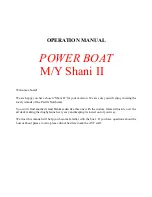
Controls
Steering
In a hydraulic system, steering wheel movement pumps
hydraulic fluid through lines to a cylinder, which
transfers movement to the outboard. A reservoir holds
extra fluid; a valve protects against overpressure.
In a mechanical system, the steering wheel connects to a
cable, which transfers movement to the outboard or stern
drive.
The operator must inspect the entire steering system
frequently for smooth, free, full range operation.
Steering cables, lines, and connections are critical to safe
operation. It is important to thoroughly check all
hardware, especially the
self-locking
nuts used to fasten
the steering link rod between the steering cable(s) and
the engine. Never replace these nuts with common or
non-self-locking nuts, which can vibrate off.
A loose
connection can result in sudden loss of steering and
control.
6-1
WARNING
Control Hazard
See engine operator’s manual and warning label
posted on boat if maneuvering speed is less than top
speed. Maneuverability is limited above specified
speed. Sudden turns may cause loss of control.
Inspect and maintain steering system regularly. An
improperly maintained system may fail, causing
sudden loss of steering control, resulting in personal
injury and property damage.
















































